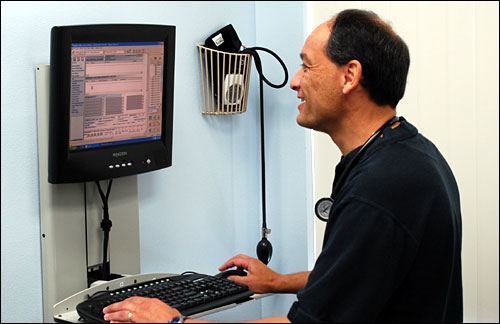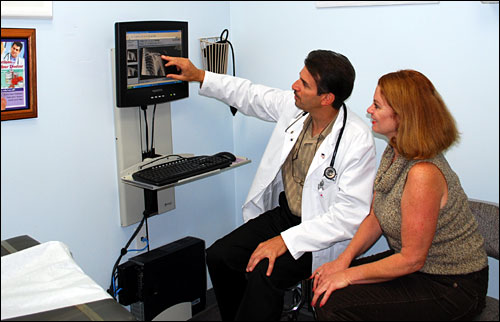EHR Supports Healthier Patients and a Healthier Bottom Line
July / August 2009
EHR Supports Healthier Patients and
a Healthier Bottom Line
Graybill Medical Group boasts 130,000 patient visits per year and annual revenues of more than $22 million. But in the tightly regulated and highly competitive Southern California market, the practice, which serves patients from three site locations in Escondido, Fallbrook, and San Marcos, is always looking for ways to enhance outcomes, increase patient safety and satisfaction, and reduce expenses.
With specific quality improvement objectives in mind, Graybill decided to implement advanced electronic health record (EHR) technology in 2004. Following a failed attempt at EHR deployment in 1999 due to inadequate planning and preparation, however, the practice took a much more prudent approach to its digital strategy.
Selecting a Quality Partner
In addition to forming a multidisciplinary EHR project committee, Graybill carefully scrutinized potential vendors, conducting detailed interviews with vendor representatives, and on-site demonstration visits with other practices that had achieved success with EHR-based quality programs.
Ultimately, the committee selected an EHR program that provides a comprehensive set of features that would support operational efficiency and enhance care delivery:
- patient medical records;
- demographic, medication, and problem list data management;
- clinical decision support tools;
- coding and compliance support;
- order generation;
- integration with diagnostic systems; and
- data transmissions and communications.
Prior to EHR implementation, Graybill implemented the companion enterprise practice management (EPM) system to maximize the value of the technology and to facilitate paperless information exchange within the practice. Fortunately, there was no need to develop interfaces between the systems, since they shared a database and resided on the same platform.
Focusing on Maximum Utility
Not wanting a repeat of its first EHR failure, Graybill formed a seven-member, multidisciplinary operations team to oversee all phases of implementation. These individuals served as process and content experts for the specific functionality they represented, devoting between 50 and 100% of their time to EHR activities, depending on their position within the medical group.
To minimize disruption to patient flow and ensure quality standards were not compromised, Graybill rolled out the system functionality by functionality. It began with practice-wide adoption of the tasking and automated medication refill processes since these features would be easiest to learn and use, as well as offer immediate and tangible benefits to users. Later, charting, documentation, and order generation were added.
Training began in December 2004. Providers, nurses, and staff were organized into groups of four or five based on office location and role. Four to five hours of training was conducted off-site one week before each stage of the go-live schedule. They were given an overview of the system and its capabilities, and were walked through the templates and workflows that were applicable to the practice.
Beyond “Electronic Charting”
Not content to simply rely upon the EHR to streamline documentation, Graybill began integrating the EHR with all of its digital imaging technologies including mammography, x-ray, and ultrasound modalities, as well as a picture archiving and communications system (PACS), shortly after implementation. This has enabled providers to more closely monitor patient compliance with preventive care and disease management services.
When a physician orders a mammogram, for example, a task is automatically created in the system notifying the radiology department that an appointment must be scheduled with the patient. Upon completion of the test, an outside radiologist reads the image via the PACS and dictates the report, which is loaded into the EHR. In addition, the referring physician has immediate access to an image when the technician completes the test. Graybill subsequently is able to import critical data and automatically associate files with a specific patient, encounter, and category.
Results are tasked to the primary care provider for review and electronic signature. The ordering physician then has a complete view of the patient’s condition and diagnosis from an office, exam room, or remote setting. Previously, all radiology reports were handled on paper. But with data flowing seamlessly between the imaging, PACS and EHR systems, Graybill providers can monitor care plans and overdue services—and have been able to reduce labor, supply, and off-site storage costs.
Advancing Quality Initiatives
Since many radiology studies such as mammograms are directly linked to key pay-for-performance (P4P) measures, results can be extracted for health maintenance and disease management reports. Rather than requiring caregivers to enter data multiple times, Graybill providers are able to simply click on the appropriate box in the EHR and the system automatically populates the health maintenance record with the appropriate patient data.
Graybill likewise developed a bi-directional interface between the EHR and its laboratory partner, LabCorp, to facilitate electronic transfer of outgoing provider orders and incoming lab results. When a physician orders a lab test, the request is sent electronically. Previously, orders were printed for patients to take to the lab themselves, creating an opportunity for it to be lost or misfiled.
Upon completion of the test by the laboratory, the Provider Approval Queue (PAQ) allows physicians to review the documents and electronically affix their signature, enabling them to make medically appropriate decisions earlier in the patient care process. The completed and approved report automatically will be appended to the appropriate patient’s electronic chart.
Increasing Safety with ePrescribing
Graybill also relies on ePrescribing to take handwritten prescriptions out of the equation in favor of safer, more efficient electronic submissions. Not only has this streamlined the provider and pharmacist workflow by removing several steps from the traditional prescription process, it also has improved patient safety by eliminating critical errors.
With a pharmacy interface, the provider is able to submit a prescription electronically, along with the appropriate patient data.
To further advance its quality initiatives, Graybill is in discussions to develop a community health solution that would allow facilities to share lab results, immunization records, medications, problem lists, and more. Currently, the hospital is pushing out hospital data as a fax, which Graybill captures in an electronic file folder and forwards to the appropriate physician, for sign-off and integration with the electronic record.
Graybill anticipates this will improve care along the continuum, and help eliminate redundancies such as tests or imaging studies repeated unnecessarily. Further, this not only saves on printing and paper costs, but eliminates several manual steps such as sorting, scanning, and filing results.

Graybill Medical Director George Rodriguez, MD, reviews pertinent patient
information at the point of care.
Photo Courtesy of Graybill Medical Group
Measuring Results
Graybill has enjoyed significant quality improvements since implementing the EHR. Before implementation, for instance, refill requests represented an 11-step processes—including fielding the call, message hand-offs, chart pulls, and more. This workflow process has now been trimmed to two steps, with fewer opportunities for errors or miscues. Similar gains have been realized with patients phoning for radiology and lab results.
Patients are enjoying increased access to their providers as well. Graybill used its new technology to introduce new processes to trim the “wait time” before a non-urgent appointment with a patient’s preferred provider. Implementation of an Advanced Access Program allows patients to see their primary care physician within 3 days. Prior to program implementation, “next available” appointments averaged 18.25 days for office visits and 26.93 for preventive care.
As a result of this program and other workflow improvements, physicians have been able to see 7% more patients without adding hours to their schedule. Between 2004 and 2007, for instance, patient volume for each of Graybill’s family practice providers rose by 310 visits.
| Technology Overview | |
| Graybill Medical Group uses NextGen Healthcare Information Systems CCHIT-certified system, NextGen EHR. |
Additionally, Graybill is better able to comply with the Medicare Advantage Program risk-adjustment model (HCC’s Hierarchial Condition Category) that dictates reimbursements. Staff review reports from the scheduling system to ensure that all senior patients had a kept appointment on an annual basis. The provider must properly reflect the patient’s health status by assessing, documenting and coding all chronic conditions on an annual basis. Graybill set up diagnosis codes at the highest level of specificity in the EHR, significantly improving overall coding scores. Reimbursement became higher for sicker patients and lower for healthy patients. As a result, senior patients are receiving recommended care management services.
In addition, Graybill participates in pay-for-performance (P4P) program initiatives to support quality improvement. These initiatives promote the adoption and use of EHR, clinical measures, and patient satisfaction results. More patients are receiving recommended preventative and care management services, particularly in the areas of childhood immunizations, breast cancer screening, cervical cancer screening, Chlamydia, and diabetes care. The number of mammograms rendered increased by 10% from 2007 to 2008 and, based on annualized figures for 2009, rendered services are anticipated to increase by 22%.
This compliance not only improves quality, but allows the practice to qualify for P4P incentives. Compare, for instance, the bonuses Graybill earned during its first 2 years of participation (Table 1).
| P4P bonus categories | 2005 (paid in 2006) |
2006 (paid in 2007) |
Variance |
| Clinical measures | $32,294.00 | $97,251.00 | $64,957.00 |
| Patient satisfaction | $18,219.00 | $163,649.00 | $145,430.00 |
| Information technology bonus | $77,537.00 | $71,851.00 | -$5,686.00 |
| Efficiency quality measurement | $0.00 | $1,845.00 | $1,845.00A |
| Total | $128,050.00 | $334,596.00 | $206,546.00 |
Table 1. P4P Bonus Payments
Payments in 2008 were consistent with 2006 payments—not because Graybill’s performance plummeted, but because the finite pool of incentive funds was divided among more practices that were adopting EHR and became eligible for a portion of the bonus.
Planning for the Future
Graybill has not stopped growing with its EHR strategy. While it continually upgrades its technologies, it also has a long-range goal of developing interfaces with other providers in the community including external radiologists, specialists and the hospital. This will further improve care throughout the area, reduce redundant services, enhance patient safety, and promote greater efficiency within healthcare.
Leslie Chapman is director of finance for Graybill Medical Group in Escondido, California.

